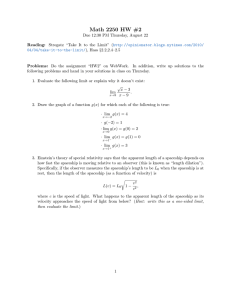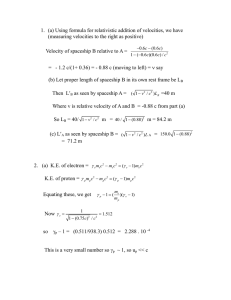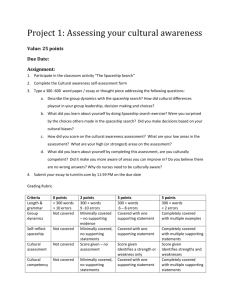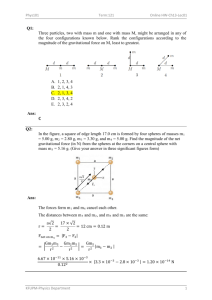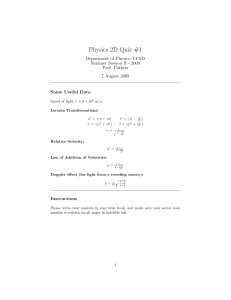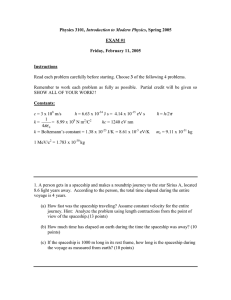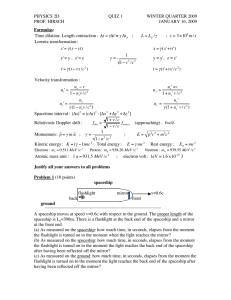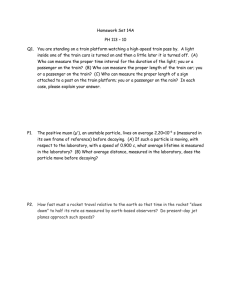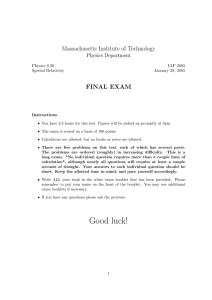Massachusetts Institute of Technology Midterm Physics Department Physics 8.20
advertisement
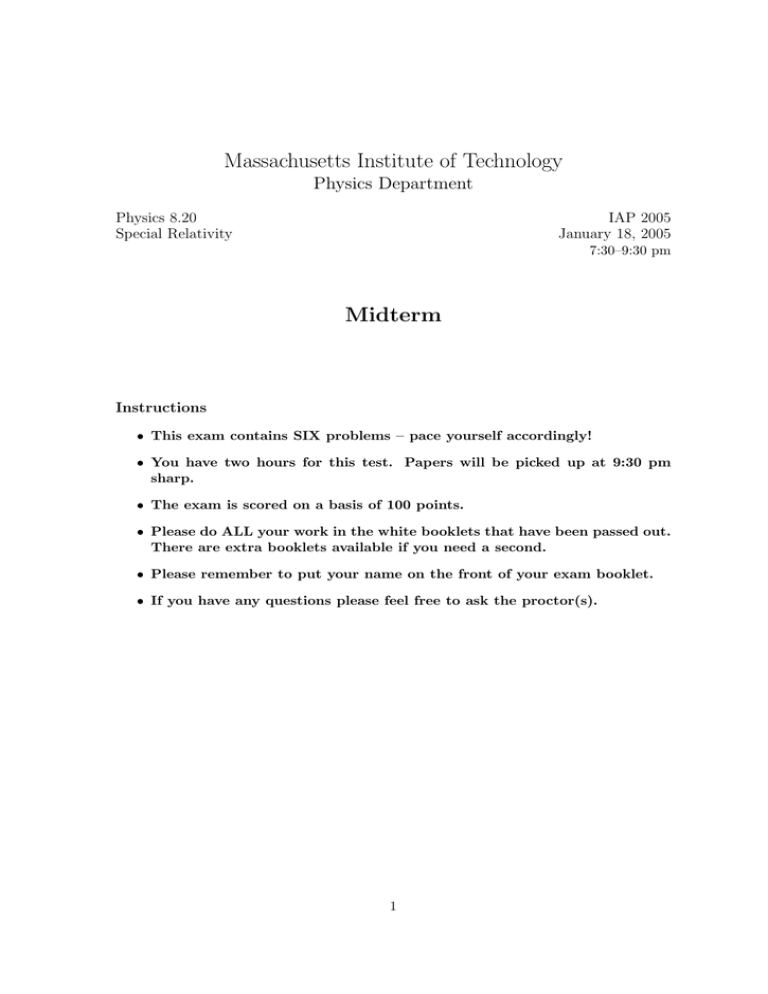
Massachusetts Institute of Technology Physics Department Physics 8.20 Special Relativity IAP 2005 January 18, 2005 7:30–9:30 pm Midterm Instructions • This exam contains SIX problems – pace yourself accordingly! • You have two hours for this test. Papers will be picked up at 9:30 pm sharp. • The exam is scored on a basis of 100 points. • Please do ALL your work in the white booklets that have been passed out. There are extra booklets available if you need a second. • Please remember to put your name on the front of your exam booklet. • If you have any questions please feel free to ask the proctor(s). 1 2 Information Lorentz transformation (along the x­axis) and its inverse x� = γ(x − βct) x = γ(x� + βct� ) y� = y y = y� z� = z z = z� ct� = γ(ct − βx) ct = γ(ct� + βx� ) � where β = v/c, and γ = 1/ 1 − β 2 . Velocity addition (relative motion along the x­axis): ux − v 1 − ux v/c2 uy u�y = γ(1 − ux v/c2 ) uz u�z = γ(1 − ux v/c2 ) u�x = Doppler shift Longitudinal � ν= 1+β ν0 1−β Quadratic equation: ax2 + bx + c = 0 � � 1 � x= −b ± b2 − 4ac 2a Binomial expansion: (1 + a)b = 1 + ba + b(b − 1) 2 a + ... 2 3 Problem 1 [30 points] Short Answer (a) [4 points] State the postulates upon which Einstein based Special Relativity. (b) [5 points] Outline a derviation of the Lorentz transformation, describing each step in no more than one sentence and omitting all algebra. (c) [2 points] Define proper length and proper time. (d) [3 points] Graph the Lorentz factor γ as a function of the speed parameter β. Graph rapidity η, defined by β = tanh η, as a function of β. (e) [3 points] Given an ensemble of particles with average lifetime τ , draw a graph that conveys the distribution of individual particle lifetimes. Choose and state your frame of reference, and appropriately label your axes. (f) [3 points] What does it mean to say that two spacetime events are “space­like separated”? “time­like separated”? “light­like separated”? (g) [3 points] In three sentences or fewer, explain the Michelson­Morley experiment. (h) [3 points] In three sentences or fewer, explain stellar abberation and its conse­ quences for the presence of an aether. (i) [3 points] In three sentences or fewer, highlight the important differences be­ tween the Doppler shift we derived in Special Relativity and that obtained using Galilean Relativity. (j) [1 point] Give the speed of light c in metric units (meters per second), to one significant digit. 4 Problem 2 [10 points] Stick at an Angle A stick of proper length �0 sits at rest in Σ, lying in the x­y plane at an angle of θ = tan−1 (3/4) with the x axis. A frame Σ� moves with velocity �v = v x̂ with respect to Σ. In Σ� , the stick is angled at 45◦ with respect to the x� axis. (a) [5 points] What is v? (b) [5 points] What is the length �� of the rod as measured in Σ� ? 5 Problem 3 [15 points] The Concept of Causality In my inertial frame of reference (Σ), event A occurs before event B. I measure these events to be separated by a time interval ΔtAB and a distance ΔxAB . (a) [5 points] What are the conditions on ΔtAB and ΔxAB such that event A will be observed to occur before event B in all inertial frames, no matter what? (b) [5 points] Suppose A and B both occur on the x­axis (i.e., y = z = 0) in my frame Σ. Consider an inertial frame (Σ� ) moving with velocity �v = v x̂ relative to my frame. Under what conditions would the two events be simultaneous in Σ� ? (c) [5 points] Again suppose A and B both occur on the x­axis (i.e., y = z = 0) in my frame Σ, and again consider an inertial frame (Σ� ) moving with velocity �v = v x̂ relative to my frame. Under what conditions would the two events occur at the same point in space in Σ� ? 6 Problem 4 [15 points] Mars shuttle service There is a spaceship shuttle service from Earth to Mars. Each spaceship is equipped with two identical lights, one at the front and one at the rear. The spaceships nor­ mally travel at a speed v0 relative to Earth, such that the headlight of a spaceship approaching Earth appears green (λ = 500 nm) and the taillight of a departing space­ ship appears red (λ = 600 nm). (a) [5 points] What is the value of v0 /c? (b) [5 points] One spaceship accelerates to overtake the spaceship ahead of it. At what speed must the overtaking spaceship travel (relative to Earth) so that the taillight of the Mars­bound spaceship ahead of it looks like a headlight (500 nm green)? (c) [5 points] What is the wavelength of the light emitted from each headlight, as measured by a mechanic in a spaceship repair shop in which the spaceship is at rest? 7 Problem 5 [15 points] Reaction time A spaceship is moving with relativistic velocity v in an inertial frame Σ in which a nearby star is at rest. This nearby star plays absolutely no role in this problem except to define the inertial frame Σ. Directly in the spaceship’s path is an asteroid, at rest with respect to the star, that will demolish the spaceship unless the spaceship pilot alters her course. The asteriod is a distance d (measured in the rest frame of the star) from the spaceship when at time t = 0 (measured in the rest frame of the star) the pilot realizes the impending disaster. Her “proper” reaction time, honed from years of video game playing, is τ . (a) [2 points] At what time t (measured in the rest frame of the star) will the spaceship hit the asteroid, if the pilot does not alter her course? (b) [4 points] Assume the pilot can save her spaceship and crew if the time to impact, as measured in her frame, is greater than her reaction time τ . What is the time to impact, as measured in her frame? (c) [2 points] Explain your result of (b) in terms of time dilation. (d) [2 points] Explain your result of (b) in terms of length contraction. (e) [5 points] Draw a spacetime diagram for this scenario, using unprimed coordi­ nates for the inertial frame Σ in which the star is at rest, and using primed coordinates for the inertial frame Σ� in which the spaceship is at rest. [Feel free to choose the origins of the two frames such that x = x� = 0 at time t = t� = 0, and draw a LARGE diagram using a full sheet of paper in your exam book.] Mark the event A that corresponds to the pilot realizing the danger, and the event B that would correspond to the spaceship hitting the asteroid. Mark on the unprimed and primed time axes the times of the two events, and mark on the unprimed and primed space axes the locations of the two events. 8 Problem 6 [15 points] Periodic emitter An object moves with relativistic speed v along the x axis in the laboratory frame. Spaced periodically along the x axis in the lab are markers, each a distance d apart, as measured in the lab. As the object passes each marker, it emits a light pulse that propagates forward (in the direction +x̂). These light pulses are detected by an observer O, sitting stationary in the lab frame along the x axis at large positive x. (a) [5 points] Draw a figure illustrating this situation, including the moving object, the periodic markers, and the observer O, and noting when and where in your illustration the moving object emits light pulses. (b) [5 points] With what frequency ν are these pulses seen by the observer O? Ex­ press your answer in terms of d, v, and the speed of light c. [Hints: (1) If a light pulse reaches the observer O at time t1 , and the next light pulse reaches the observer at time t2 , the frequency ν is the reciprocal of the difference: ν = 1/(Δt) = 1/(t2 − t1 ). (2) You may think of each light pulse as a “pellet” with speed equal to c. (3) You may wish to carefully set up an expression for the times at which two sequential light pulses, one emitted from the object as it passes a marker at x = 0, and one emitted from the object as it passes a marker at x = d, reach the observer.] (c) [5 points] � Express your answer for ν from part (b) in terms of ν0 = v/d and γ = 1/ 1 − v 2 /c2 , in the limit γ � 1. [Neither of the symbols v nor β should appear in the answer to this part, in which you will make an approximation that neglects terms of order (c − v)/c.]
